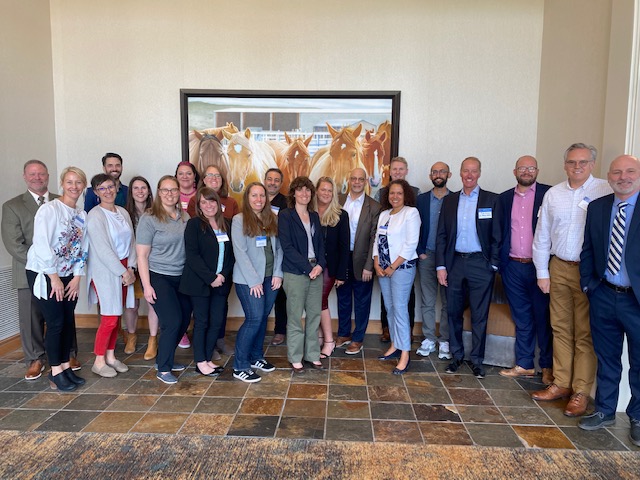Colorado is a bit of an enigma. It’s home to numerous dense and high population areas including the Denver/Boulder metro area, Fort Collins to the north and Colorado Springs to the south. But as we learned in an interview with the state’s broadband director Brandy Reitter, outside those metro areas of the eighth largest state geographically, there have been significant challenges to deploying internet service.
Colorado’s challenges include mountains blocking lines of sight, a granite-rich topography that makes underground builds pricey, and sparsely populated desert plains on the West side of the state, noted Reitter, whose official title is executive director of the the Colorado Broadband Office.
Combine this with an unemployment rate lower than the national average and a workforce shortage, and you might think that Reitter might be ready to find a new job in the private sector!
But, in a time where state broadband offices are seeing turnover in staffing and leadership, Reitter is embracing the challenges and leading one of the longest running state broadband offices in the nation.
Reflecting on more than $1 billion of federal funding (BEAD and CPF) coming to Colorado, Reitter told Telecompetitor that “This is very special, I don’t take this for granted. I am having an amazing time because of the people I work with and for.”
The Colorado broadband office has 16 full-time employees that are seasoned in GIS, broadband deployment, legislation and legal, communications, and community engagement. Most recently, the team has been focused on its Capital Projects Fund (CPF) allocations.
Extensive Demand
As Telecompetitor recently reported, Colorado received requests for four times its CPF allocation of $162 million. Reitter tells Telecompetitor that awarded recipients will be informed by early December. Parameters for awards are similar to what they will be for BEAD and include:
- Prioritizing unserved and then underserved
- Fiber preferred – over 96% of applications were fiber
- Availability speeds of at least 100/20 Mbps
- Extra points for scalability potential to 100/100 and eventually symmetrical gigabit speeds
Colorado has already been making its own investments in broadband for more than half a decade. Through the State’s Broadband Deployment Fund, Colorado has invested $56.1M to connect over 29,000 households.
State efforts include a February 2022 Executive Order from Governor Jared Polis setting “…an ambitious goal to connect over 99% of Coloradans to affordable, high-speed broadband in the next five years…”
Today’s ‘digital divide’ in Colorado is approximately 10% and equates to approximately 191K residences.
Pleased and Pragmatic
Colorado is receiving $826.5 million in BEAD funding, a number that Reitter says is “a little more than I was thinking, I am pretty excited about that number, I think the challenge process helped a lot.”
The Colorado broadband office focused on quality over quantity during the challenge process, with 60% of its 15k location and availability challenges accepted. She says that while the Colorado broadband office ran a public campaign encouraging residents to challenge locations on the map, the state uses the same data today in its map as the FCC map does in its map.
Naturally pragmatic, Reitter recognizes that while challenges helped boost the funding that Colorado received, it’s time to live with the FCC’s current availability map.
The High Costs of Colorado
Reitter speculates that Colorado’s BEAD funding was also boosted because of the high-cost threshold for deployment in challenging topographies in the fiber-first program.
As for how Colorado will define its own ‘high cost per location threshold,’ Reitter says her office is in the process of defining parameters and that Colorado will not be using a ‘one size fits all’ approach because the variety of topographies in the state makes deployment costs vary significantly.
Reitter says the process will include multiple data sources, including the NTIA’s model and eligible entity planning tool, analysis from CostQuest, Colorado’s maps, and historical data from recent local deployments. The state also will be using a consultant to provide another mapping tool to identify high-cost areas.
Perhaps mostly because of the large allocation Colorado received, Reitter does not anticipate anything like the four times demand she saw during the CPF round of funding requests.

Accepting Feedback
To-date, Reitter and team have submitted Colorado’s five-year action plan and Volumes 1 and 2 of its initial proposal for the BEAD program. Volume 2 was released on October 25 and just concluded its 30-day public comment period.
Reitter expects to begin taking applications for funding in early summer of 2024. The anticipated timeline also calls for funding to be distributed before construction season of 2025. Colorado is only doing one round of funding.
“We are fortunate but of course having a lot of money makes it harder because you have to make tougher decisions,” reflects Reitter.
Additional information about Colorado broadband, including links to state resources and Telecompetitor coverage, can be found on the Broadband Nation page for the state.



